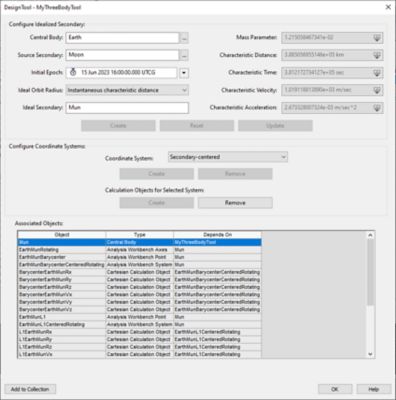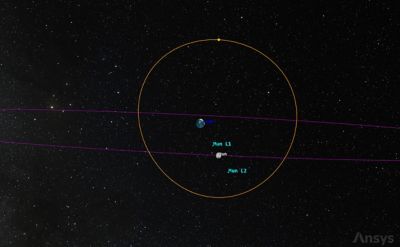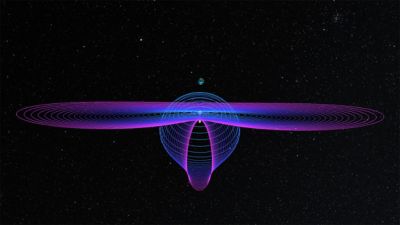-
United States -
United Kingdom -
India -
France -
Deutschland -
Italia -
日本 -
대한민국 -
中国 -
台灣
-
Ansys는 학생들에게 시뮬레이션 엔지니어링 소프트웨어를 무료로 제공함으로써 오늘날의 학생들의 성장을 지속적으로 지원하고 있습니다.
-
Ansys는 학생들에게 시뮬레이션 엔지니어링 소프트웨어를 무료로 제공함으로써 오늘날의 학생들의 성장을 지속적으로 지원하고 있습니다.
-
Ansys는 학생들에게 시뮬레이션 엔지니어링 소프트웨어를 무료로 제공함으로써 오늘날의 학생들의 성장을 지속적으로 지원하고 있습니다.
ANSYS BLOG
July 28, 2023
Ansys 2023 R2: Getting Started with the Three-body Problem
In the early seventeenth century, Johannes Kepler gave us the solution to orbital motion. What are now known as Kepler’s three laws of planetary motion can be found in the pages of Kepler’s “Astronomia Nova,” published in 1609. He explained that one body orbiting another, motivated by their mutual attraction, will orbit in an elliptical path (or following other conic section solutions like a hyperbola or a parabola). So, “Problem solved! Let’s all go home before lunch,” is what all spacecraft trajectory folks say every day shortly after breakfast, right? Fortunately, for those in the spacecraft trajectory business, the answer is a resounding, “Nope, still some work to do.”
Kepler solved, in a nice, concise, closed-form analytical way, the two-body problem. What quickly followed among the mathematical and astronomical community was the search for solutions to the three- and n-body problems. It turns out that just adding one more body to your gravitational cohort increases the complexity of the underlying mathematical problem to the point that no closed-form analytical solution exists.
Simplify the Circular Restricted Three-body Problem
Ansys Systems Tool Kit (STK) and Ansys Orbit Determination Tool Kit (ODTK) have long been used to plan, design, and fly missions in complex gravitational regimes. Indeed, a particular three-body problem of relevance is that of Earth, the Moon, and your spacecraft flying to the Moon. Various missions to the Moon and its local neighborhood have leveraged the built-in capabilities of STK to plan and meet the associated mission requirements for these missions. Adjustable levels of model fidelity in the simulation space enable analysis and planning associated with particular aspects of the larger problem. Sometimes these capabilities are so mature that they have evolved beyond the starting phases for mission design and analysis.
Ansys can help you get started in cislunar space by modeling three-body solutions. In particular, we’re bolstering the capabilities introduced in STK 11.7 with a particular flavor of the three-body problem: the circular restricted three-body problem (CR3BP). This model represents a medium level of fidelity that simultaneously incorporates the gravitational effects of two massive bodies on some smaller body, like a spacecraft. The advantages of this model lie in the rich theoretical notions available for analysis of the associated dynamical system. Elegant mathematical constructions emerge from such an approach and lead to an enhanced understanding of the larger system. The associated approaches enable unique end-to-end solutions that persist in form in higher-fidelity models. They also uncover a more fundamental understanding of the design space.
The CR3BP model within STK has required, to this point, a substantial amount of software environment configuration from the user. In the 2023 R2 release, we have added a new design tool in the STK component browser to offset this effort. The CR3BP Setup Tool allows you to quickly configure your STK environment to support three-body analysis with the associated mathematical model. For example, you can construct a cislunar three-body system associated with Earth and the Moon. To account for the unique requirements of the medium-fidelity CR3BP model, namely that the massive bodies move consistently with circular orbits, we introduce an idealized Moon and call it Mun. A view of the setup tool for such a system appears in Figure 1.

Figure 1. A view of the CR3BP Setup Tool in Ansys STK used to create an idealized system for cislunar analysis, designated the “Earth-Mun system.”
STK is configured to simulate CR3BP motion and associated orbital solutions, such as those shown in the following figures.

Figure 2. A halo orbit about the L1 libration point in the Earth-Mun system.

Figure 3. Families of orbital solutions associated with the L1 libration point in the Earth-Mun system.
While we can’t write down a general solution to the full three-body problem, we can use medium-fidelity models like the CR3BP and numerical simulation to find unique and exotic particular solutions like those showcased above. It’s never been easier to get started with such explorations in STK.
See how Ansys STK and Ansys ODTK have been updated in the 2023 R2 release.










